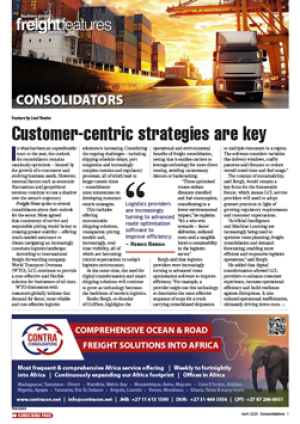By switching from Durban
to Walvis Bay, a client in
Lusaka won a contract
with major retailer Shoprite
because he was able to offer
improved and predictable
transit times.
It’s one of several success
stories that Walvis Bay
Corridor Group CEO
Johny Smith outlined last
week when he updated
FTW on grand plans not
only to upgrade the port
but also the road and rail
infrastructure which are
crucial elements of the
supply chain mix.
“Ten years ago when we
started this initiative, Walvis
Bay had no direct callers –
now we have connections to
all major trade lanes,” Smith
told FTW.
“Our objective is to
develop Walvis Bay as
an alternative trade route
serving Angola, Botswana,
Zambia, Zimbabwe, DRC,
Gauteng – and even as far
as Malawi and Tanzania
because of transit time you
can save along this route,”
said Smith.
Focusing on the Gauteng
market, he believes Walvis
Bay adds value for timecritical
cargo.
“Ships from Europe and
the Americas have to pass
Walvis Bay – and from
Walvis Bay to Durban takes
5-7 days by sea. If you
offload in Walvis Bay, it
takes two days.
Since 1994, the port has
invested R800m and the
draught has been deepened
to 12.8m.
“Ten years ago we
handled 20 000 containers –
last year we handled
260 000.”
And according to Smith,
the port will invest R2.7-bn
in next 3-4 years, deepening
the draught to 16m and
doubling capacity to 500 000
TEUs per annum.
And the investment, says
Smith, is all about cutting
the cost of logistics for the
region, and this involves
the intermodal links as
well.
“There’s a missing link
in terms of railways along
the Trans Kalahari Corridor
– the railway stops 140km
before you reach Botswana
and then continues from
Lobatse. There is 700km
of railway missing but the
Namibia and Botswana
governments have put out an
expression of interest for the
railway between Botswana
and Namibia.
“There’s a lot of coal
in Botswana and they are
looking at an alternative
through Namibia or the
east – we are trying to run
faster than Mozambique to
ensure that Namibia gets the
business.”
Significant progress has
also been made with regard
to border hours.
“In 2007 the border
hours were extended. But a
recent agreement between
Botswana, Namibia and
South Africa will see the
introduction of a 24-hour
border.”
According to Smith, it’s
just a question of sorting
out human resources
requirements between the
various agencies involved.
“We believe we have
developed a very good
alternative trade route – and
that people should have
choices.
“Ultimately the benefit
for Southern Africa is
that we can reduce the
cost of logistics not only
by reducing transit time
but through the additional
benefits of competitive rates,
a congestion-free port and
zero pilferage.”
Walvis Bay switch swings major contract for Lusaka shipper
22 Oct 2010 - by Joy Orlek
0 Comments
FTW - 22 Oct 10

22 Oct 2010
22 Oct 2010
22 Oct 2010
22 Oct 2010
22 Oct 2010
22 Oct 2010
22 Oct 2010
Border Beat
Featured Jobs
New
New
